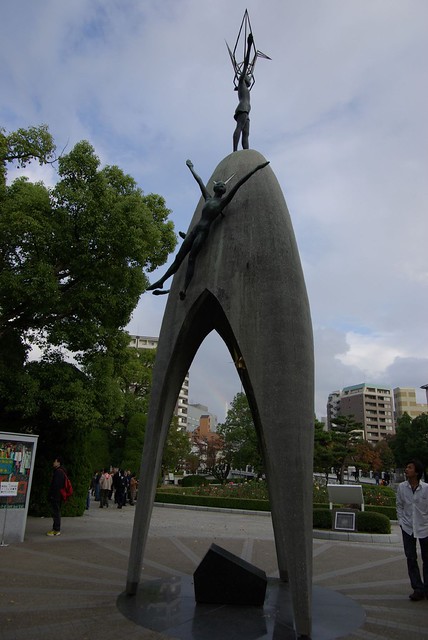Children's Peace Monument located in the Hiroshima Peace
Memorial Park, Japan is a memorial in remembrance of all the children who died
as a result of dropping of atom bombs on Hiroshima and Nagasaki.
The memorial also known "Tower of Thousand Cranes" is based
on the true and poignant story of a Sadako Sasaki, a young girl who died at the
age of 12 years due to the nuclear radiation she had received on August 6, 1945
at the age of 2. The affect of radiation manifested in 1955 when she was
diagnosed with radiation-induced leukaemia and was ultimately hospitalised.
Based on a popular Japanese belief she innocently believed that if she made
thousand origami birds (cranes) she would be cured of her disease. Although she
was very weak but she was determined to make thousand cranes and tried to make
thousand cranes so that she could get well. Unfortunately before she could reach
her target, death took her away on the morning of October 25, 1955.
Her friends and class mates shocked by her sudden illness and
death decided to erect a memorial to comfort her soul and also to express their
desire for peace. Their idea soon spread all over Japan and became not only a
National but an International movement. With the aid of funds raised through
donations from over 3,100 schools in Japan and other foreign countries the
monument was finally unveiled on Children's Day - May 5, 1958.
Designed by native artists Kazuo Kikuchi and Kiyoshi Ikebe,
the 20 metres high monument consists of a bomb shaped high hollow structure topped with
statue of Sadako Sasaki holding over her head an origami crane with her
outstretched arms conveying hope for a peace. Two more statues, one of a boy and
other of a girl, are attached to the structure representing all the children who
died due to bombing of the two towns.
Under the main structure, a bronze crane hangs from a
traditional peace bell. The bronze crane works as a wind chime when it is pushed
against the bell. The bird and the bell were donated by Nobel Laureate in
Physics, Hideki Yukawa, the Japanese theoretical physicist and the first
Japanese to win the Nobel prize.
The base of the monument carries a message to prevent further
deaths of children by atomic bombs. Inscribed in Japanese on a black marble are
the words of a junior high school student;
This is our cry.
This is our prayer.
For building peace in the world.
Even today children from all over the World send colourful paper
cranes to be placed at the memorial. Small cubicles around the memorial were
added later to house these origami cranes strung on strings. As fresh batches arrive the older ones are
taken away.
Image from
Flickr is by
tsuda

Image from
Google Maps is by
toshi
& skirt

Image from
Flickr is by
FlutterbyNessa
View location in
Google Street View
Source of info and more info:






0 comments:
Post a Comment